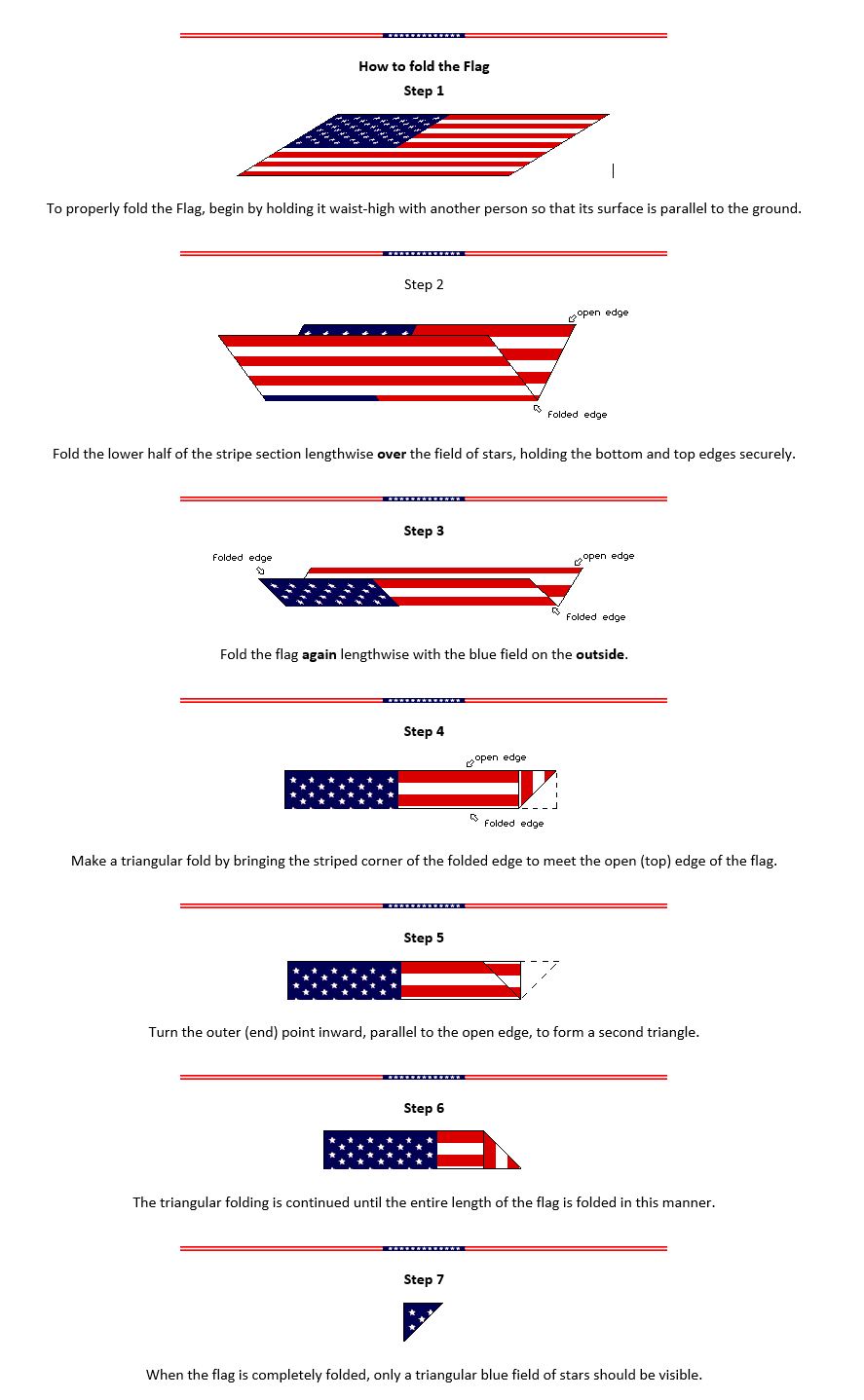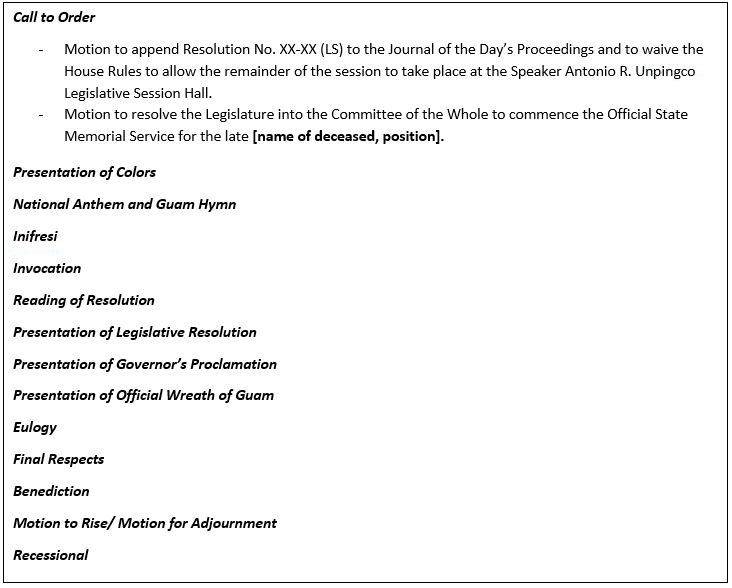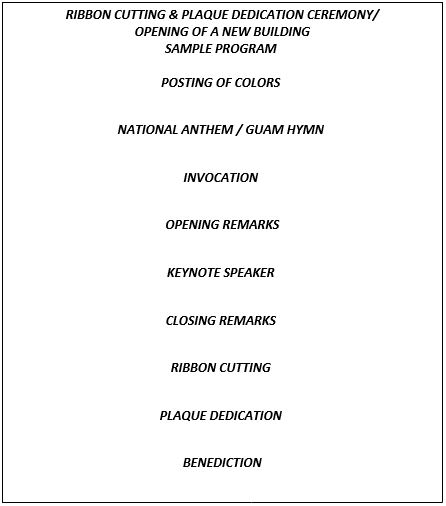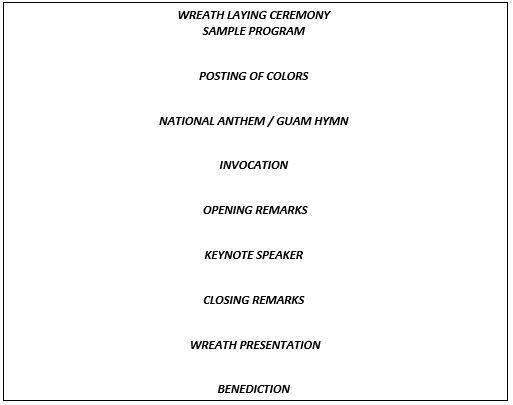|
Section 6. Ceremonial Occasions
At any official event, it is standard protocol to open with the National Anthem and the Guam Hymn. Once the National Anthem and the Guam Hymn have been sung, the official program may begin.
Today, it is common practice to include the recitation of the Inifresi, and the Kåten Kulu and Bendision. Each of these ceremonies have a cultural importance and help set the tone of respect and honor at official events. The number of opening ceremonies to include in an event in addition to the National Anthem and Guam Hymn is at the discretion of the Host or Event Planner If there are strict time constraints for the event, the Host may choose to limit the number of ceremonies in the program.
When the National Anthem is played, one stands and faces the music, or the U.S. flag, if one is displayed. If outdoors, those in uniform should salute at the first note of the anthem; if indoors, they should stand at attention but not salute. All others should stand at attention, men removing their headdress, with the right hand holding it at the left shoulder, the hand being over the heart. All present, except those in uniform should stand at attention facing the flag, with the right hand over the heart. The positions described for all present should be held until the last note of music is played.
When the Fanohge Chamoru is played, one stands and faces the music, or the Guam. flag, if one is displayed. All present, except those in uniform should stand at attention facing the flag, with the right hand over the heart. This position should be held until the last note of music is played.
Visit Guampedia: Guam Hymn / Fanoghe Chamorro for more information on the Guam Hymn.
When a high-ranking guest from another country is present, it is customary to play their national anthem as well.
The Inifresi is a pledge to the Island of Guam written by Bernadita Camacho Dungca, PhD. Under Public Law 21-34, the Inifresi was included in the Chamorro Language curriculum. Below are the words to the Inifresi and its translation.
Ginen i mas takhelo' gi Hinasso-ku,
i mas takhalom gi Kurason-hu,
yan i mas figo' na Nina'siñå-hu,
Hu ufresen maisa yu' para bai hu Prutehi
yan hu Difende i Hinengge,
i Kottura,
i Lengguahi,
i Aire,
i Hanom yan i tano' Chamoru,
ni'Irensiå-ku Direchu ginen as Yu'os Tåta.
Este hu Afitma gi hilo' i bipblia yan i banderå-hu,
i banderan Guåhan. |
From the highest of my thoughts,
from the deepest of my heart,
and with the utmost of my strength,
I offer myself to protect
and to defend the beliefs,
the culture,
the language,
the air,
the water and the land of the Chamorro,
which are our inherent God-given rights.
This I will affirm by the holy words and our banner,
the flag of Guåhan! |
The Kåten Kulu and Bendision is a ceremony usually performed by a cultural group. During this ceremony, a conch shell is blown and a song and dance is performed. This song calls on the ancestors for blessings and guidance.
Public Law 829 of the 77th Congress as amended by Public Law 94-344 and in Executive Order N. 10834 issued on July 4, 1960, sets forth the rules and regulations on the correct use of the U.S. Flag.
It is the universal custom to display the flag only from sunrise to sunset on buildings and on stationary flagstaffs in the open. However, the flag may be displayed at night upon special occasions when it is desired to produce a patriotic effect.
The flag should be hoisted briskly and lowered ceremoniously.
The flag should be displayed daily, weather permitting, on or near the main administration building of every public institution. The flag should be displayed in or near every polling pace on election day and should be displayed during school days in or near every schoolhouse.
No other flag or pennant should be placed above, or, if on the same level, to the right of the flag of the United States of America.
When flags of two or more nations are displayed, they are to be flown from separate staffs of the same height and size in alphabetical order. The flags should be of approximately equal size. The U.S. flag should be given the place of honor to its own right, the flags to the left of the U.S. flag. The display of the flag of one nation above that of another nation is forbidden in time of peace.
The flag should form a distinctive feature of the ceremony of unveiling a statue or monument, but it should never be used as the covering for the statue or monument.
The flag should not be displayed on days when the weather is inclement, except when an all-weather flag is displayed.
The flag should not be displayed on a float in a parade except from a staff.
The flag should not be draped over the hood, top, sides, or back of a vehicle or of a railroad train or a boat. When the flag is displayed on a motor car, the staff shall be fixed firmly to the chassis or clamped to the right fender.
The flag should be flown at half-staff upon the death of the President or a former President for a period of 30 days from the date of death; ten days in the case of the Vice President, Chief Justice or retired Chief Justice of the Supreme Court. In case of members of Congress and Associate Justices of the Supreme Court, it should be flown from the date of death until internment.
Upon the death of a governor or a former governor, the flag should be flown from the date of death until internment.
For other local officials, unless specified by the Legislature, the governor shall issue a proclamation to govern the period of mourning.
Permission must be obtained from another country before its flag is flown at half-staff. Unless permission is granted, it is recommended that the flags of other countries not be flown when the flag of the United States is at half-staff.
During the ceremony of hoisting or lowering the flag or when the flag is passing in a parade or in a review, all persons present should face the flag, stand at attention, and salute. Those present in uniform should render the military salute.
When not in uniform, men should remove their headdress (if one is worn) with the right hand, continuing to hold the headdress in the right hand, the hand held over the heart.
Men without hats should salute by placing the right hand over the heart. The salute to the flag in the moving column should be rendered at the moment the flag passes.
When both the Guam and U.S. flags are flown together, the U.S. flag should be on the left side and the Guam flag on the right. When several flags are flown, they can be lined up alphabetically, with the exception of the U.S. flag. The U.S. flag should be posted on its own right in the front center of other flags. As a common courtesy, when a head of state visits Guam, the national flag of that country should be flown.
When the American flag is lowered, no part of it should touch the ground or any other object; it should be received by waiting hands and arms. To store the flag, it should be folded neatly and ceremoniously. Proper steps to folding the American flag are as follows:

This video created by the Westpoint Military Academy demonstrates the proper technique for folding the American flag.
“There shall be and there is adopted an official territorial flag of Guam, which consists of a rectangular field of marine blue, 78 Inches long and inches wide, trimmed on a all sides with a border of deep red, two inches in width and having in its center the Guam Coat of Arms. There shall be and there is hereby adopted an official Coat of Arms of Guam, which shall consist of an upright two-pointed oval scene…”
“There shall be and there is hereby adopted a Great Seal of the Territory of Guam, which shall consist of the Coat of Arms of Guam…” (Government Code of Guam)
The figures on the design symbolize specific Chamorro traits. The canoe typifies the courage of the ancient Chamorros who skillfully and fearlessly used the craft to span the Pacific. The coconut tree, growing in unfertile sand, symbolizes determination and, with its fronds open to the sky, defies the elements to bend it to its will. The backdrop is a representation of a popular tourist attraction, Two Lovers’ Point, located in the village of Harmon. Two Lovers’ Point is a popular Guam myth.
Folding the Guam flag mirrors that of the folding of the U.S. Flag
When the Guam flag is removed from the casket during a State Funeral, no part of it should touch the ground or any other object; it should be received by waiting hands and arms of 8 individual pallbearers. To fold the flag, it should be folded neatly and ceremoniously. Proper steps to folding the Guam flag are as follows:

The Catholic Church plays a significant role in the spiritual, social and cultural life of the people of Guam. Protestant groups also contribute to the spiritual and social fabric of Guam’s growing diversity of peoples.
The Parish priest continues to play a very important part in the life of the local community. A Catholic priest is usually appointed by the Legislature to serve as Chaplain. In all important islandwide official ceremonies, the Archbishop, or his designated representative, plays a significant part.
The Archbishop is introduced as His Excellency Archbishop __________ of the Archdiocese of Agana, or simply as Archbishop ________. A priest is addressed as Reverend ___________, or as Father ________.
In official communications, the Archbishop is addressed as:
Most Reverend _______, OFM Cap., D.D.*
Archbishop of Agana
196 Cuesta San Ramon Ste B.
Hagatña, Guam 96910
If a Legislative Resolution is to be presented at a Mass, it is suggested that it be presented prior to the start of the Mass or after the reception of communion.
If a visiting head of state desires to attend a Mass at the Dulce Nombre de Maria
Cathedral-Basilica, or in a parish church, those assigned as the official government hosts should inform the Archbishop so that proper recognition may be rightly accorded.
In a Protestant church, the minister or pastor is most generally addressed and introduced as Reverend. Titles of Vicar, Bishop, and/or Archbishop would occur only rarely in local protocol contexts, and usually only with the Episcopal (i.e., Anglican) and sometimes the Methodist denominations.
The President of the Guam Ministerial Association or his representative is also invited to take part in official functions. The Guam Ministerial Association is an association or a large number of Protestant clergy in the community.
In official communications, the President of the Guam Ministerial Association is addressed as:
The Reverend________
President of the Guam Ministerial Association
P.O. Box 2099
Agana, Guam 96910
It should be noted that there are additional religious groups on island which are not represented by either the Archdiocese of Agana or the Guam Ministerial Association.
*Depending on religious order; contact Chancery Office.
According to Public Law 15-89, the Legislature, on behalf of the people of Guam, shall honor with a State Funeral any person who at the time of his death or before served as a Senator, Governor, Lieutenant Governor, Judge, Non-Voting Delegate to Washington, or any citizen who, in the opinion of the Committee on Rules of the Legislature, has displayed exemplary service for the island and the people of Guam, if the family of the deceased so agrees.
Before arrangements are made, the personal desires of the deceased and the family must be known. Once the family’s representative informs the Speaker regarding the family’s wishes, plans are underway for a state funeral.
At the executive level, the governor proclaims a period of mourning, usually from the day of death to the day of internment. All U.S. and Guam flags are flown half-mast during this period.
The memorial service is held at the legislative session hall. The family representative works closely with the Speaker and the governor on the various items in the service. At the appointed hour, the Speaker calls the legislature to order. After legislative motions are entertained by the Speaker, dignitaries are escorted to the hall.
The casket of the deceased is escorted through the Session Hall main doors by the senators of the Guam Legislature followed by the family members of the deceased. The memorial service begins with the rendition of the anthems followed by the invocation. The prepared legislative resolution is read by the Legislative Secretary and presented to the family of the deceased by the Speaker, Vice-Speaker, Legislative Secretary and the Minority Leader. The Governor then presents the prepared Proclamation of Guam to the family members. The official Wreath of Guam is then presented to the family by the Governor, Speaker and Chief Justice. A prayer is then said. The eulogy is then delivered by someone usually selected by the family and one who was an intimate friend of the deceased. Last respects are then paid to the family by the Speaker, Governor, Chief Justice, senators, podium guests and dignitaries. The benediction is delivered by the President of Ministerial Association. The service ends with the adjournment of Session.
A 17-gun salute honoring deceased senators is appropriate. A 21-gun salute is afforded to former governors. None are afforded to mayors or judges.
A gun salute is fired at noon on the day of the funeral on the day of the funeral. This portion of the ceremony is arranged with a military service; the National Guard, or the Guam Police Department. Last respects are paid by participants in the service and government officials. The Speaker offers brief remarks followed by the benediction. The Legislature then rises to adjourn. From the legislative hall, the remains of the deceased will be moved to lie in repose at a designated place of worship. The funeral cortege proceeds to the final resting place. An internment rite is observed ending with a final salute to the deceased. Arrangements mentioned in this text can be modified to conform to the wishes of the family of the deceased.
Sample State Funeral Program

A Change of Command Ceremony is an honored product of the rich heritage of Naval tradition. It is a formal ritual conducted before the assembled company of the command. It is a custom wholly naval and is nearly unique in the world today. Custom has established that this ceremony be formal and impressive, for it is a transfer of total responsibility, authority, and accountability from one individual to another. Parading All Hands at Quarters and the public reading of official orders stem from those days when movement of mail and persons was a very slow process. This procedure was designed to ensure that only duly authorized officers held command and that all hands were aware of its authenticity.
The heart of the ceremony is the formal reading of official orders by both the relieving officer and the officer to be relieved. Command passes with the utterance by the relieving officer, “I relieve you, sir!” The officer being relieved responds, “I stand relieved!” This simple procedure signifies the passing of total responsibility for the command.
The outgoing commanding officer determines the extent of the ceremony and assumes responsibility for all arrangements. In the case of a flag or general officer, invitations are normally headed by a replica of the personal flag of the officer being relieved. In some instances, change of command and retirement ceremonies are combined. An invitation to a reception following the ceremony may be included on a smaller card which is enclosed with the basic invitation.
The Dining-In is a formal dinner function. It may honor a departing officer or welcome a new one. It may also give recognition to a dignitary, an individual, unit achievements, or it may simply be a pleasant way for officers at a station to get better acquainted. Spouses are not invited. Medals are worn by all members of the mess and the military guests, including retired officers. A civilian guest wears black tie, or other appropriate attire. The attire is stated in the invitation. The primary elements of a Dining-In include a fine dinner, toasting, remarks, and camaraderie.
This formal dinner function follows the same general format and serves somewhat the same purpose as the Dining-In. The basic difference is the presence of spouses and guests. This function is conducted in a more relaxed and less ceremonious atmosphere.
The purpose of this reception is to welcome new members into the command and to bid farewell to those departing. The dress will depend on the venue, but is typically casual. Most Hail and Farewells are sponsored and attended by a command’s wardroom and spouses.
Retirement ceremonies are a formal retiring from military service after completion of a career whose length will vary as prescribed by law and other factors. In the Navy, this formal ceremony concludes with the retiree being “piped over the side.” All guests are expected to rise in honor of the retiree. Typically, an informal reception follows.
Other ceremonies hosted by the military on Guam include the various service birthday balls, Armed Forces Day, and POW-MIA Day.
Government officials and distinguished guests are often invited to events such as the opening of a new building, a ribbon cutting or a plaque dedication. At these events, official protocol should be observed. Below is a sample of a typical program used at these types of events.

Wreath laying ceremonies are solemn events conducted to honor of someone who has passed. Wreaths are placed at grave sites or memorials in memory of those who have passed. At these events, official protocol should be observed. Below is a sample of a typical program used for a wreath laying ceremony.

For receiving a body of a fallen service member, regardless of rank or branch, the Governor’s Protocol Office will work closely with the local military Casualty Office to receive the fallen Service Member with utmost dignity and respect.
|
|
